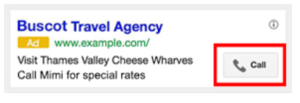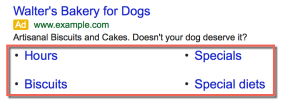In the previous post in our series about our client onboarding process, we talked about account structure and strategy.
With those pieces in place, we’re ready to move onto the next (and most visible) step in the process: PPC ad messaging.
As I mentioned in a recent Search Engine Land column, ad messaging used to be relatively simple. We figured out the product features and benefits to emphasize, wrote the text, and gave the client’s marketing team two or three options to choose from. And that was that!

Today, ad messaging is much more complex. With so many ad extensions to include, the problem is less how to squeeze all relevant points into an ad and more how to spread relevant points effectively across messaging and extensions.
Ad Extensions
So what are these many ad extensions we keep talking about? Ad extensions are AdWords features that marketers can use to expand their PPC ads. At last count, there were six manual extensions and four automated extensions.
Here are a few of the ad extensions we use most often (using examples from AdWords Help):
1. Call extensions
Call extensions add phone numbers to standard text ads. They may display as a call button or numeric text.

2. Callout extensions
Callout extensions add additional text to search ads, such as information about your business or services. They won’t always display and aren’t clickable links.

3. Sitelink extensions
Sitelink extensions add website links and additional information to your ad. They won’t always display. When they do, they may display as headlines and short descriptions or as headlines only (as below).

4. Structured snippet extensions
Structured snippet extensions highlight specific aspects of your products and services in your search ads. Snippets must come under one of 12 predefined Google headers. They won’t always display and aren’t clickable links.
As you can see, a skilled copywriter can use one or several of these extensions (in combination with the regular copy text) to deliver a more targeted, descriptive and persuasive ad.
Our PPC Ad Messaging Approach
As with any ad creative, our approach combines analysis and creativity. We use our analysis (which keywords to use, which extensions to use, what product features/benefits/promotions to highlight) to set the broad direction for the ad. We then use our creativity to make it persuasive.
Our process follows three steps, although in reality the process is not so linear:
1. Select keywords
This gets back to account structure and strategy. Once you have a solid account structure and strategy in place, selecting the right keywords should be relatively easy.
2. Write ad copy (including ad extensions)
With so many ad extensions available, it’s more important than ever to apply an overarching strategy to ad messaging. Ad hoc approaches will eventually hurt performance or lead to other issues, which is why we take a holistic approach.
Therefore, we look at each campaign, ad group and keywords as a whole before deciding how to proceed. We also make sure all ads work together without undermining each other.
What does that mean for you and your marketing team? Basically, it means you’ll receive a detailed messaging roadmap from us detailing our approach and outlining our ad messaging recommendations.
3. Test and optimize
Even though we’ve done all the legwork to make sure our PPC ad messaging is on track, there’s always room for improvement. Consequently, we conduct regular testing to make sure all ads are optimized and converting well.
Once we have ad messaging in place for your marketing team’s PPC campaign, we move on to the next stage of our client onboarding process: remarketing.
Start with our introductory post to read this series from the beginning.






